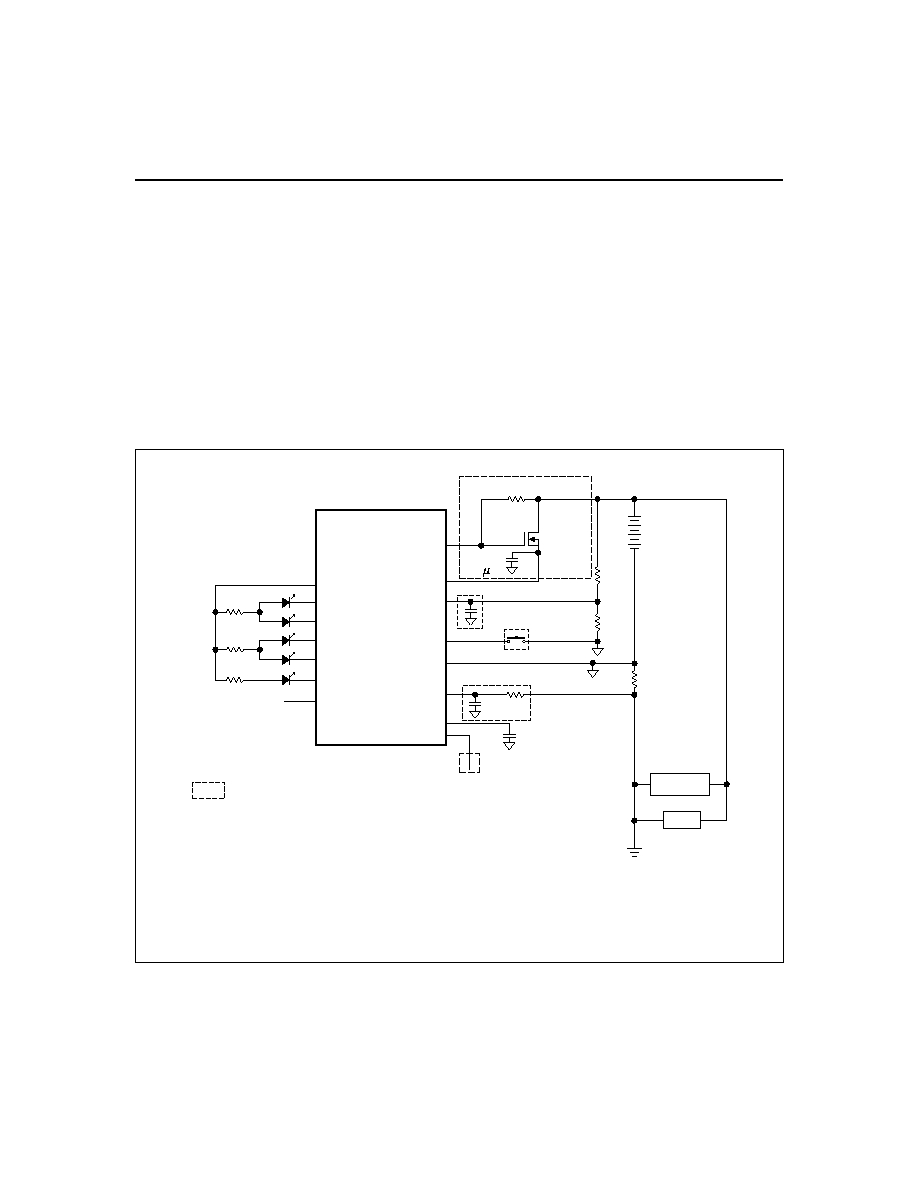 | ÐлекÑÑоннÑй компоненÑ: BQ2011K | СкаÑаÑÑ:  PDF PDF  ZIP ZIP |
Äîêóìåíòàöèÿ è îïèñàíèÿ www.docs.chipfind.ru

1
Features
Conservative and repeatable
measurement of available charge
in rechargeable batteries
Designed for portable equipment
such as power tools with high dis-
charge rates
Designed for battery pack inte-
gration
-
120
µA typical standby current
(self-discharge estimation mode)
-
Small size enables imple-
mentations in as little as
1
2
square inch of PCB
Direct drive of LEDs for capacity
display
Self-discharge compensation us-
ing internal temperature sensor
Simple single-wire serial commu-
nications port for subassembly
testing
16-pin narrow SOIC
General Description
The bq2011K Gas Gauge IC is in-
tended for battery-pack installation to
maintain an accurate record of a bat-
tery's available charge. The IC moni-
tors a voltage drop across a sense re-
sistor connected in series between the
negative battery terminal and ground
to determine charge and discharge ac-
tivity of the battery. The bq2011K is
designed for systems such as power
tools with very high discharge rates.
Battery self-discharge is estimated
based on an internal timer and tem-
perature sensor. Compensations for
battery temperature and rate of
charge or discharge are applied to
t h e c h a r g e , d i s c h a r g e , a n d
selfdischarge calculations to provide
available charge information across
a wide range of operating conditions.
Initial battery capacity is set using
the PROG
1-4
and SPFC pins. Actual
battery capacity is automatically
"learned" in the course of a dis-
charge cycle from full to empty and
may be displayed depending on the
display mode.
Nominal available charge may be di-
rectly indicated using a five-seg-
ment LED display. These segments
are used to graphically indicate
nominal available charge.
The bq2011K supports a simple
single-line bidirectional serial link to
an external processor (common
ground). The bq2011K outputs bat-
tery information in response to exter-
nal commands over the serial link. To
support subassembly testing, the
outputs may also be controlled by
command. The external processor
may also overwrite some of the
bq2011K gas gauge data registers.
The bq2011K may operate directly
from four cells. With the REF out-
put and an external transistor, a
simple, inexpensive regulator can be
built to provide V
CC
from a greater
number of cells.
Internal registers include available
charge, temperature, capacity, battery
ID, and battery status.
LCOM
LED common output
SEG
1
/PROG
1
LED segment 1/ Program
1 input
SEG
2
/PROG
2
LED segment 2 / Program
2 input
SEG
3
/PROG
3
LED segment 3/ Program
3 input
SEG
4
/PROG
4
LED segment 4/ Program
4 input
SEG
5
LED segment 5
SPFC
Programmed full count
selection input
REF
Voltage reference output
NC
No connect
DQ
Serial communications
input/output
RBI
Register backup input
SB
Battery sense input
DISP
Display control input
SR
Sense resistor input
V
CC
3.06.5V
V
SS
Negative battery terminal
Gas Gauge IC for
High Discharge Rates
bq2011K
10/97 B
Pin Connections
Pin Names
1
PN2011JK.eps
16-Pin Narrow SOIC
2
3
4
5
6
7
8
16
15
14
13
12
11
10
9
VCC
REF
NC
DQ
RBI
SB
DISP
SR
LCOM
SEG1/PROG1
SEG2/PROG2
SEG3/PROG3
SEG4/PROG4
SEG5
SPFC
VSS

Pin Descriptions
LCOM
LED common
Open-drain output switches V
CC
to source cur-
rent for the LEDs. The switch is off during ini-
tialization to allow reading of PROG
1-4
pull-up
or pull-down program resistors. LCOM is high
impedance when the display is off.
SEG
1
SEG
5
LED display segment outputs
Each output may activate an LED to sink
the current sourced from LCOM, the battery,
or V
CC
.
PROG
1
PROG
4
Programmed full count selection inputs
(dual function with SEG
1
- SEG
4
)
These three-level input pins define the pro-
grammed full count (PFC) in conjunction
with SPFC pin, define the display mode and
enable or disable self-discharge.
SPFC
Programmed full count selection input
This three-level input pin along with PROG
1-3
define the programmed full count (PFC)
thresholds described in Table 1. The state of
the SPFC pin is only read immediately after
a reset condition.
SR
Sense resistor input
The voltage drop (V
SR
) across the sense re-
sistor R
S
is monitored and integrated over
time to interpret charge and discharge activ-
ity. The SR input is tied to the low side of
the sense resistor and battery pack ground
(see Figure 1). V
SR
> V
SS
indicates discharge,
and V
SR
< V
SS
indicates charge. The effec-
tive voltage drop, V
SRO
, as seen by the
bq2011K is V
SR
+ V
OS
(see Table 4).
NC
No connect
DISP
Display control input
DISP floating allows the LED display to
be active during certain charge and dis-
charge conditions. Transitioning DISP
low activates the display for 4
± 0.5 seconds.
SB
Secondary battery input
This input monitors the single-cell voltage
potential through a high-impedance resis-
tive divider network for the end-of-discharge
voltage (EDV) threshold and maximum cell
voltage (MCV).
RBI
Register backup input
This input is used to provide backup poten-
tial to the bq2011K registers during periods
when V
CC
< 3V. A storage capacitor should
be connected to RBI.
DQ
Serial I/O pin
This is an open-drain bidirectional pin.
REF
Voltage reference output for regulator
REF provides a voltage reference output for
an optional micro-regulator.
V
CC
Supply voltage input
V
SS
Ground
2
bq2011K

Functional Description
General Operation
The bq2011K determines battery capacity by monitoring
the amount of charge input to or removed from a recharge-
able battery. The bq2011K measures discharge and charge
currents, estimates self-discharge, monitors the battery for
low-battery voltage thresholds, and compensates for tem-
perature and charge/discharge rates. The charge measure-
ment is made by monitoring the voltage across a small-
value series sense resistor between the battery's negative
terminal and ground. The available battery charge is de-
termined by monitoring this voltage over time and correct-
ing the measurement for the environmental and operating
conditions.
Figure 1 shows a typical battery pack application of the
bq2011K using the LED display with absolute mode as a
charge-state indicator. The absolute display mode uses
the programmed full count (PFC) as the full reference,
forcing each segment of the display to represent a fixed
amount of charge.
A push-button display feature is
available for momentarily enabling the LED display.
The bq2011K monitors the charge and discharge cur-
rents as a voltage across a sense resistor (see R
S
in Fig-
ure 1). A filter between the negative battery terminal
and the SR pin may be required if the rate of change of
the battery current is too great.
Register Backup
The bq2011K RBI input pin is intended to be used with
a storage capacitor to provide backup potential to the in-
3
bq2011K
FG201103.eps
SPFC
SEG5
SEG4/PROG4
SEG3/PROG3
SEG2/PROG2
SEG1/PROG1
VSS
DISP
SB
VCC
REF
bq2011K
Gas Gauge IC
LCOM
SR
RBI
DQ
VCC
C1
0.1 F
Q1
ZVNL110A
R1
RS
RB1
RB2
Load
Charger
Indicates optional.
Directly connect to VCC across 4 cells (4.8V nominal and should not
exceed 6.5V) with a resistor and a Zener diode to limit voltage during charge.
Otherwise, R1, C1, and Q1 are needed for regulation of >4 cells.
Programming resistors and ESD-protection diodes are not shown.
R-C on SR may be required (application-specific), where the maximum R should not exceed 20K.
Figure 1. Application Diagram: LED Display, Absolute Mode

ternal bq2011K registers when V
CC
momentarily drops be-
low 3.0V. V
CC
is output on RBI when V
CC
is above 3.0V.
After V
CC
rises above 3.0V, the bq2011K checks the internal
registers for data loss or corruption. If data has changed,
then the NAC register is cleared, and the LMD register is
loaded with the initial PFC.
Voltage Thresholds
In conjunction with monitoring V
SR
for charge/discharge
currents, the bq2011K monitors the single-cell battery po-
tential through the SB pin. The single-cell voltage poten-
tial is determined through a resistor-divider network per
the following equation:
RB
RB
N
1
2
1
=
-
where N is the number of cells, RB
1
is connected to the
positive battery terminal, and RB
2
is connected to the
negative battery terminal. The single-cell battery volt-
age is monitored for the end-of-discharge voltage (EDV)
and for maximum cell voltage (MCV). The EDV thresh-
old level is used to determine when the battery has
reached an "empty" state, and the MCV threshold is used
for fault detection during charging. The MCV threshold
for the bq2011K is fixed at:
V
MCV
= 2.00V
The EDV threshold varies as a function of discharge cur-
rent as follows:
Reset
Reset can be accomplished with a command over the se-
rial port as described on page 13.
Temperature
The bq2011K internally determines the temperature in
10°C steps centered from -35°C to +85°C. The tempera-
ture steps are used to adapt charge and discharge rate
compensations, self-discharge counting, and available
charge display translation.
The temperature range is
available over the serial port in 10°C increments as
shown below:
Layout Considerations
The bq2011K measures the voltage differential between
the SR and V
SS
pins. V
OS
(the offset voltage at the SR
pin) is greatly affected by PC board layout. For optimal
results, the PC board layout should follow the strict rule of
a single-point ground return.
Sharing high-current
ground with small signal ground causes undesirable noise
on the small signal nodes. Additionally:
I
The capacitors (SB and V
CC
) should be placed as
close as possible to the SB and V
CC
pins, respectively,
and their paths to V
SS
should be as short as possible.
A high-quality ceramic capacitor of 0.1
µf is
recommended for V
CC
.
I
The sense resistor (R
S
) should be as close as possible
to the bq2011K.
I
The R-C on the SR pin should be located as close as
possible to the SR pin. The maximum R should not
exceed 20K.
Gas Gauge Operation
The operational overview diagram in Figure 2 illus-
trates the operation of the bq2011K. The bq2011K accu-
mulates a measure of charge and discharge currents, as
well as an estimation of self-discharge. Charge currents
are temperature and rate compensated, whereas self-
discharge is only temperature compensated.
The main counter, Nominal Available Charge (NAC),
represents the available battery capacity at any given
time.
Battery charging increments the NAC register,
while battery discharging and self-discharge decrement
4
bq2011K
TMPGG (hex)
Temperature Range
0x
< -30°C
1x
-30°C to -20°C
2x
-20°C to -10°C
3x
-10°C to 0°C
4x
0°C to 10°C
5x
10°C to 20°C
6x
20°C to 30°C
7x
30°C to 40°C
8x
40°C to 50°C
9x
50°C to 60°C
Ax
60°C to 70°C
Bx
70°C to 80°C
Cx
> 80°C
V
SRO
(mV)
V
EDV
(V)
0
10
<
V
SRO
1.160
10
20
<
V
SRO
1.124
20
40
<
V
SRO
1.060
40
60
<
V
SRO
0.960
V
SRO
> 60
0 (OVLD)

the NAC register and increment the DCR (Discharge
Count Register).
The Discharge Count Register (DCR) is used to update
the Last Measured Discharge (LMD) register only if a
complete battery discharge from full to empty occurs
without any partial battery charges.
Therefore, the
bq2011K adapts its capacity determination based on the
actual conditions of discharge.
The battery's initial capacity is equal to the Pro-
grammed Full Count (PFC) shown in Table 1.
Until
LMD is updated, NAC counts up to but not beyond this
threshold during subsequent charges. This approach al-
lows the gas gauge to be charger-independent and com-
patible with any type of charge regime.
1.
Last Measured Discharge (LMD) or learned
battery capacity:
LMD is the last measured discharge capacity of the
battery. On initialization (application of V
CC
or bat-
tery replacement), LMD = PFC. During subsequent
discharges, the LMD is updated with the latest
measured capacity in the Discharge Count Register
(DCR) representing a discharge from full to below
EDV. A qualified discharge is necessary for a ca-
pacity transfer from the DCR to the LMD register.
The LMD also serves as the 100% reference thresh-
old used by the relative display mode.
2.
Programmed Full Count (PFC) or initial bat-
tery capacity:
The initial LMD and gas gauge rate values are pro-
grammed by using PFC. The PFC also provides the
100% reference for the absolute display mode. The
bq2011K is configured for a given application by se-
lecting a PFC value from Table 1. The correct PFC
may be determined by multiplying the rated bat-
tery capacity in mAh by the sense resistor value:
Battery capacity (mAh) * sense resistor () =
PFC (mVh)
Selecting a PFC slightly less than the rated capac-
ity for absolute mode provides capacity above the
full reference for much of the battery's life.
Example: Selecting a PFC Value
Given:
Sense resistor = 0.002
Number of cells = 6
Capacity = 1800mAh, NiCd cells
Current range = 1A to 80A
Absolute display mode
Self-discharge =
C
80
Voltage drop across sense resistor = 2mV to 160mV
5
bq2011K
FG201104.eps
Temperature
Compensation
Charge
Current
Discharge
Current
Self-Discharge
Timer
Temperature
Translation
Nominal
Available
Charge
(NAC)
Last
Measured
Discharged
(LMD)
Discharge
Count
Register
(DCR)
<
Qualified
Transfer
+
Rate and
Temperature
Compensation
Rate and
Temperature
Compensation
Temperature Step,
Other Data
+
-
Inputs
Main Counters
and Capacity
Reference (LMD)
Outputs
Serial
Port
Chip-Controlled
Available Charge
LED Display
-
+
Figure 2. Operational Overview




